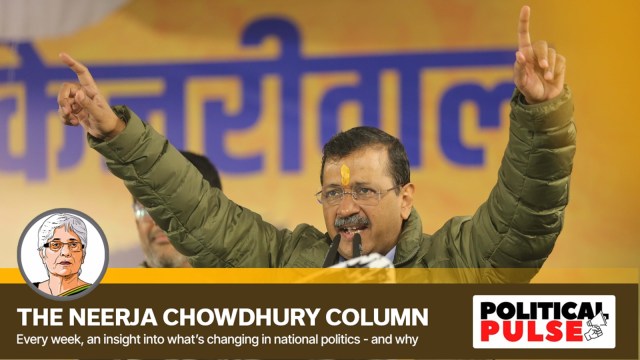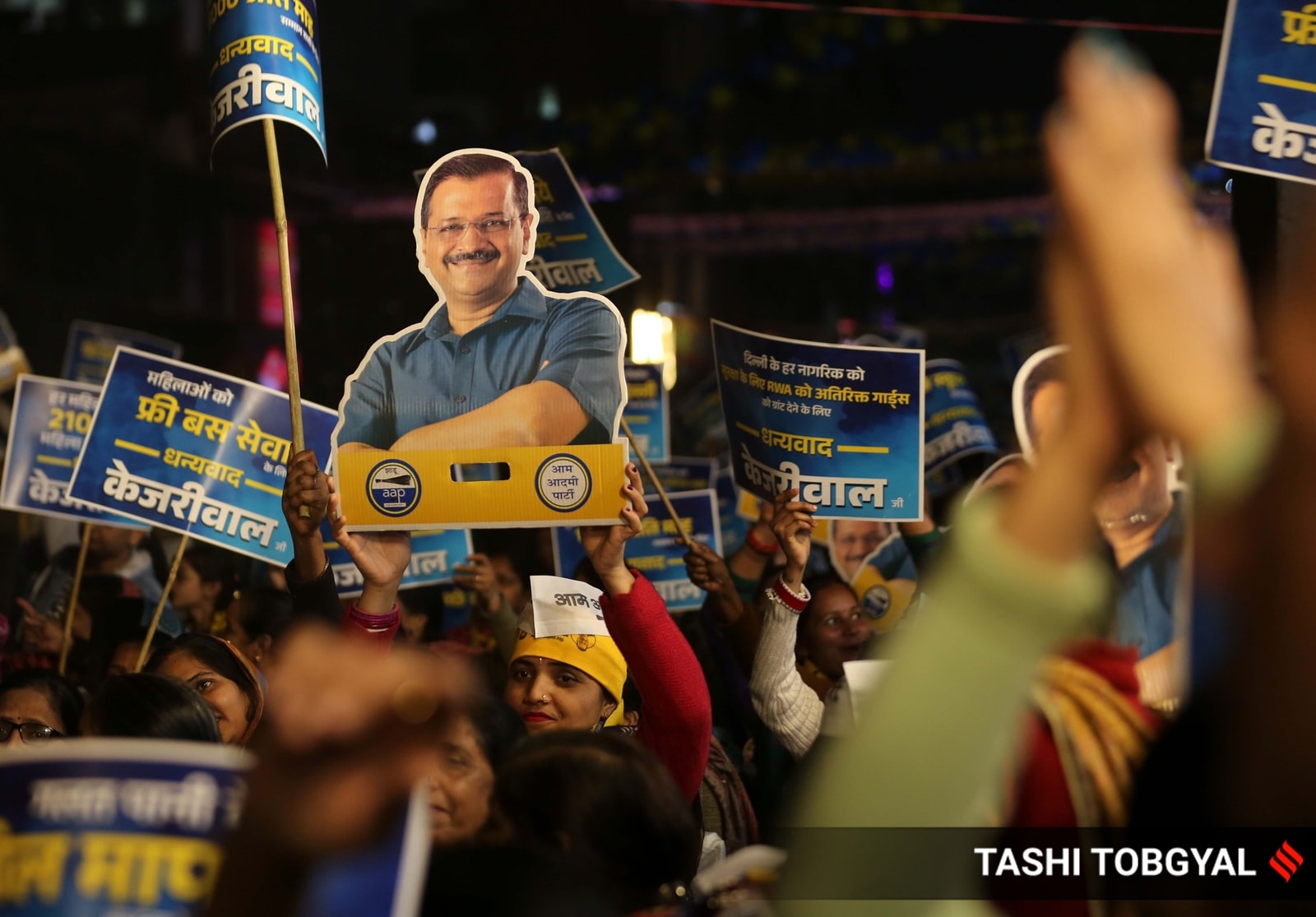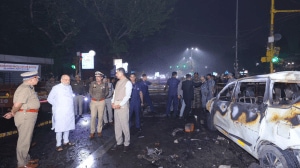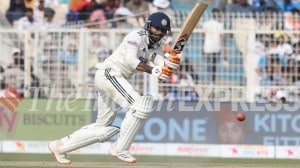Behind Arvind Kejriwal’s outreach to the middle class: Does AAP chief sense a shift?
Moulded by the middle-class-driven anti-corruption movement of Anna Hazare, Arvind Kejriwal made a successful transition to politics with the support of the poor. Before Delhi votes on February 5, he is assiduously reaching out to the middle class.
 AAP national convenor and former Delhi CM Arvind Kejriwal. (Express file photo by Tashi Tobgyal)
AAP national convenor and former Delhi CM Arvind Kejriwal. (Express file photo by Tashi Tobgyal)Arvind Kerjriwal’s sudden outreach to the normally ignored middle class has taken many by surprise, particularly as his Aam Aadmi Party (AAP) has been geared to catering to Delhi’s poor, jhuggi-jhopri dwellers, and scooter-wallahs.
It is not as if the middle class has not supported Kejriwal. The tallies that the AAP scored in 2015 and 2020 — 67 MLAs and 62 MLAs, respectively — could not have been possible without the support of Delhi’s middle class. This time, his pitch to the middle class underscores a reality many have sensed: the middle class shows signs of fatigue with a government that has been in the saddle for 10 years even as the poorer sections swear by him and the line oft-repeated by many of them is “kaam toh kiya hai (he has done work)”.
Kejriwal is essentially a creature of the middle-class driven “India Against Corruption” movement of 2010-11 led by Anna Hazare that created the environment that sent the Manmohan Singh government packing in 2014. He made the successful transition from a movement to a political party, secured its national party status. and positioned it as the party of the poor.
If the socio-economic survey undertaken by the Delhi government in 2018 is anything to go by, at best, 8% of the families in the National Capital spent between Rs 25,000 and Rs 50,000 per month and can be categorised as the middle class in Delhi. So, theoretically speaking, Kejriwal does not have to worry unduly about such a small number though private agencies believe that Delhi’s middle class is as big as 45% of the population of the megalopolis.
 AAP supporters at a rally addressed by former Delhi CM Arvind Kejriwal, ahead of the Delhi Assembly elections scheduled for February 5. (Express photo by Tashi Tobgyal)
AAP supporters at a rally addressed by former Delhi CM Arvind Kejriwal, ahead of the Delhi Assembly elections scheduled for February 5. (Express photo by Tashi Tobgyal)
A calculated move?
Kejriwal’s middle-class card appears to be calculated to achieve three things. Always quick to sense the direction of the wind, the AAP chief, who is fighting an existential battle this time, may realise that this not-so-large, though highly articulate and media-savvy section of society may have become disenchanted with his party and may seek a change on February 5. They are likely to look at the BJP as an alternative — it has been out of power in Delhi for more than a quarter century — than a struggling Congress that, at best, is likely to cut into the AAP’s votes.
The AAP chief may also worry that voter fatigue and an anti-incumbency of 12 years may also take its toll on some of the “underclasses” who have stayed by his side. For, a poor person who happily sends her child to a reformed government school also worries about the potholed roads she has to navigate or about the hacking cough she suffers from, breathing polluted air day after day, even as she goes to a mohalla clinic for free medical help. At the end of the day, the usually loud middle class does influence others around it.
Kejriwal is trying to keep his party as broad-based as possible. Significantly, his seven-point manifesto for the middle class is not a list of promises. They are demands he has put out, as if on behalf of the middle class, to the Narendra Modi government on issues that agitate them today and have led to their growing economic hardship.
Even if not a spokesperson for them, he is trying to demonstrate that he stands by their side as their well-wisher. His pitch is calculated to remind the middle class what the Modi government has not done for them. It comes as a warning, saying “beware” before you consider voting for the BJP.
When Kejriwal recently spoke about the “tax terrorism’ the middle class has to put up with, or the GST they pay on goods for daily use, or called for 10% of the Union government’s budget to be used on education, and a fee cap in private schools, he was touching a raw nerve as the middle class knows huge concessions have been given to the rich and “revdis” to the poor. As the AAP chief put it evocatively in Hindi, the middle class “pees rahe hain (getting squeezed)”.
Coming before the presentation of the Union Budget on February 1, Kejriwal may also want to put Finance Minister Nirmala Sitharaman on the spot. As it is, there has been a growing demand from certain sections that taxes — direct as well as GST slapped on essential items — be reduced to give relief to the middle class.
Middle class versus Mandal politics
The BJP’s narrative against “freebies” also plays on the middle-class angst that revdis for the poor are doled out at their expense.
Normally, political parties concentrate on the concerns of the poor and the backward who are larger in number, and Kejriwal is no exception. His promise of free electricity (up to 200 units) and water (up to 20,000 litres per household), government school reforms, access to free medicines at mohalla clinics, free bus tickets for women, and a promise of Rs 2,100 to women each month are all geared to reach out to the poorer sections, who remain his best bet.
For successive Prime Ministers and Chief Ministers, it has not been possible to win elections without the support of the poor. Indira Gandhi relied on the “garibi hatao (end poverty)“ slogan to win the 1971 election, V P Singh implemented the Mandal report to give reservation to the Other Backward Classes (OBCs) in government jobs; and Narendra Modi used the word poor in his first speech as Prime Minister in 2014 and created a pro-poor safety net with his welfare measures.
It was Singh’s Mandal politics that led to a pushback from the middle class. The middle-class youth saw the doors closing on them and there were widespread protests. Whether it was Gandhians, Marxists, religious hardliners, or secularists, the middle class, largely synonymous with the upper castes, united in opposition to Mandal, which to them spelt shrinking opportunities.
They turned to the BJP for protection and support and the party withdrew support to the V P Singh government. The Mandir movement, or Hindutva, as a manifestation of Hindu nationalism, grew in the years that followed, with this aggrieved middle class becoming a mainstay of this upsurge. It was later when Modi, from an OBC group, took over, positioning himself as the “chaiwala” PM, that he roped in the poorer and backward sections to widen the BJP’s base.
Kejriwal perhaps now senses the beginnings of a middle-class pushback nationally and is hoping to tap into this force not just for the imminent Delhi election but beyond it for his long-term goals.
(Neerja Chowdhury, Contributing Editor, The Indian Express, has covered the last 11 Lok Sabha elections. She is the author of How Prime Ministers Decide)
- 01
- 02
- 03
- 04
- 05































